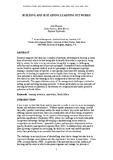- CERES Home
- →
- School of Management (SoM)
- →
- Staff publications (SoM)
- →
- View Item
JavaScript is disabled for your browser. Some features of this site may not work without it.
| dc.contributor.author | Bessant, John | |
| dc.contributor.author | Barnes, Justin | |
| dc.contributor.author | Morris, Mike | |
| dc.contributor.author | Kaplinsky, Raphael | |
| dc.date.accessioned | 2009-03-19T15:34:18Z | |
| dc.date.available | 2009-03-19T15:34:18Z | |
| dc.date.issued | 2003-06 | |
| dc.identifier.citation | John Bessant, Justin Barnes, Mike Morris, Raphael Kaplinsky, Building and Sustaining Learning Networks. EurOMA & POMS Joint International Conference, Lake Como, Italy, 18-20 June, 2003. | en_UK |
| dc.identifier.uri | http://hdl.handle.net/1826/3288 | |
| dc.description.abstract | Research suggests that there are a number of potential advantages to learning in some form of network which include being able to benefit from other’s experience, being able to reduce the risks in experimentation, being able to engage in challenging reflection and in making use of peer group support. Examples of such configurations can be found in regional clusters, in sector groupings, in heterogeneous groups sharing a common topic of interest, in user groups concerned with learning around a particular technology or application and in supply chain learning. Although there is clear potential in such shared learning and some evidence of its being achieved in a few cases it is clear that learning in such configurations does not take place automatically. This paper addresses some of the management challenges involved in setting up and nurturing learning networks. It draws particularly on case examples of learning networks in operation in the automotive components and timber products industries in South Africa. | en_UK |
| dc.language.iso | en | en_UK |
| dc.title | Building and Sustaining Learning Networks. | en_UK |
| dc.type | Conference paper | en_UK |
Files in this item
This item appears in the following Collection(s)
-
Staff publications (SoM) [1258]
